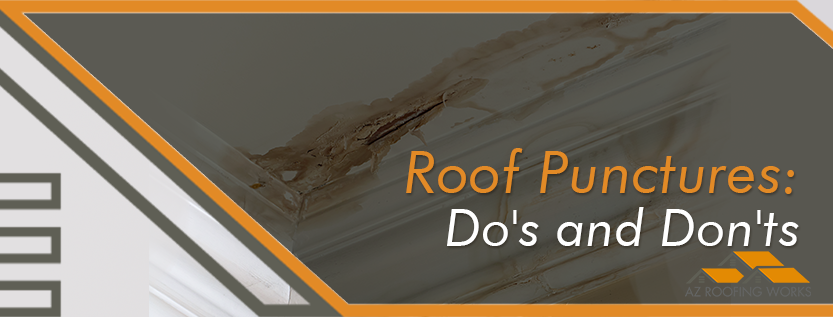Roof Punctures: Do’s and Don’ts
Extreme weather conditions in the Mesa area wreak havoc on your home’s roof.
When temperatures reach over 105* F each summer, your roofing materials warp.
Chilly winter months make the distorted materials shrink and crack.
Cracked roofing materials leave vulnerable spots in your roof.
Weakened roofing materials go from baking in the heat to dealing with monsoons.
You might not know your roof has any faults until water pours into your home.
Roof punctures are a common problem for older homes in the area.
Years of abuse from the weather weakens the roof deck.
This guide will help you spot punctures and protect your roof.
Natural Causes of Roof Punctures
Living in the desert poses a unique set of challenges for homeowners.
Mesa and its neighboring cities have two types of storms.
The first is a monsoon with sudden downpours. The second type of storm is a haboob.
A haboob is a large dust storm. These storms come with wind speeds of 30-65 MPH.
The fast-moving dust particles act like a sandblaster, wearing down your roofing materials.
At 50 MPH, winds can rip off roof shingles and tiles.
When a haboob reaches 60 MPH, it could drop a tree on your roof.
Any loose debris in your yard can likewise land on the roof and puncture it.
Man-Made Roof Puncture Problems
After monsoon season passes, be careful when checking your roof.
Foot traffic over a weak spot may lead to a hole in the roof.
Give the roof a visual inspection from the ground, instead.
Do you have a satellite attached to your roof?
When was the last time a roofer checked around it for signs of damage?
Wind and hail damage will loosen the satellite’s base and cause a leak.
How to Deal With a Punctured Roof
The first step is to ensure that the roof puncture isn’t leaking on any electronics.
If it is, shut off the power and call for emergency roof repair.
You’ll also need to contact an electrician to check the affected power outlets.
Homeowners with punctured flat roofs shouldn’t wait to get it repaired.
Holes in the protective membrane lead to mold infestation.
Mold eats porous building materials and causes more roof punctures.
Do not rely on a tarp to cover the roof puncture. Tarps don’t work well on flat roofs because they don’t lay flat.
High wind speeds during the monsoon season will rip the tarp off a peaked roof.
Repair Your Mesa Area Roof Before Monsoon Season Arrives
Roof punctures big and small have the potential to ruin your entire roof.
The area around the puncture may absorb rainwater and collapse.
Neglecting to repair a puncture exposes your home to mold spores.
The spores do more than damage your home; they can harm your family, as well.
Animals can widen the weak spots and crawl into your attic.
If that happens, you have to deal with multiple infestations, plus a leaky roof.
Save yourself a world of frustration and contact AZ Roofing Works.
Our roofers are ready to tackle any roof punctures or other roofing problems.
We specialize in tile, shingle, and flat roof repair.
If you’re looking for a trusted roof repair company in Mesa, AZ to help you with all of your roofing needs, contact the experts at AZ Roofing Works for a Free Roofing Estimate! Call (602) 283-3383!






